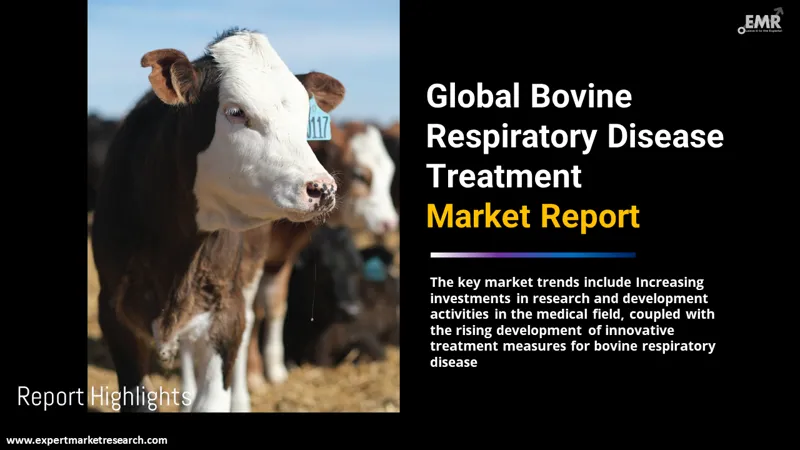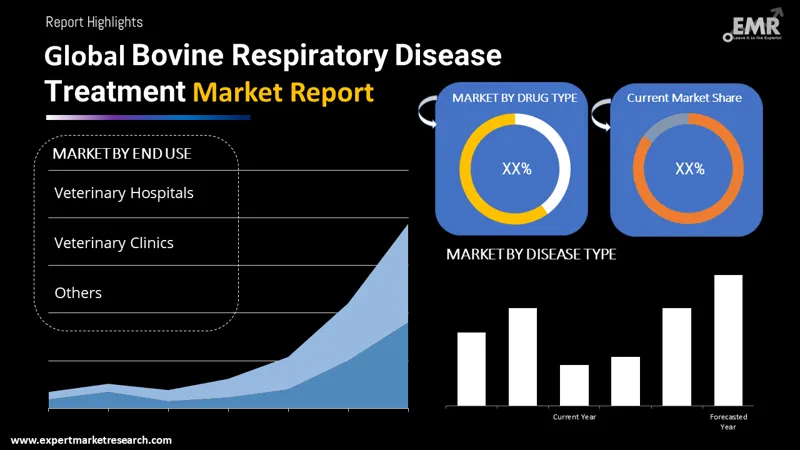
Consumer Insights
Uncover trends and behaviors shaping consumer choices today
Procurement Insights
Optimize your sourcing strategy with key market data
Industry Stats
Stay ahead with the latest trends and market analysis.
The global bovine respiratory disease treatment market is estimated to develop at a CAGR of 11.50% during 2026-2035. Bovine respiratory disease is a generic term for respiratory disease in cattle triggered by multiple factors, either individually or collectively. Bovine respiratory disease may attack the lower or upper respiratory tract. North America and Europe are likely to be significant markets.
Base Year
Historical Period
Forecast Period
Compound Annual Growth Rate
11.5%
2026-2035
*this image is indicative*
Bovine respiratory disease is a damaging disease that affects cattle health and leads to high mortality. In fact, the disease is a key cause of death in preweaned calves in USA and is behind almost fifty percent of total feedlot deaths. Bovine respiratory disease touches more animals than all other ailments collectively and costs the industry over $550 million per year. In Europe, bovine respiratory disease is a major source of morbidity and mortality of dairy youngstock and beef cattle.

Read more about this report - REQUEST FREE SAMPLE COPY IN PDF
Bovine respiratory disease may be triggered by pathogens – viral as well as bacterial. Stress contributes to the disease complex. Stress factors include humidity, weather, change in temperature, weaning, change of feed, etc. Clinical symptoms rely on several factors such as animal age, stage of disease and causative organism. Symptoms include fever; depression; reduced appetite; dullness; shallow and rapid breathing; coughing; serous, purulent or bloody eye and nasal release; and salivation.
Many virus and bacteria strains may trigger the disease, making it challenging to treat effectively. Treatment is particularly directed to the illness and the indications. Medication may include anti-infectious agents (Sulfas and Antibiotics), antiparasiticides, non-steroidal anti-inflammatories, mucolytics, bronchodilators, oral rehydration fluids. Several antimicrobial drugs are indicated to treat bovine respiratory disease. Drugs such as florfenicol, tulathromycin, enrofloxacin, and danofloxacin have been reported to display similar effectiveness in treating the condition. However, antimicrobial resistance associated with the use of these drugs is an important consideration.
Nonsteroidal anti-inflammatories (NSAIDs) (combined with an antimicrobial drug) are generally indicated to treat the condition. Such an approach has also been suggested to improve animal growth.
Bovine respiratory disease has serious economic impacts. In the American beef industry, the disease is a leading source of mortality and morbidity in feedlots, leading to loss in performance, health, and quality of carcass. The dairy industry in the US is significantly affected by bovine respiratory disease as the ailment forms a key cause of death in weaned calves; bovine respiratory disease impacts survivability and decreases dairy performance. Economic losses include loss due to death, reduced weight and decreased rate of weight gain, and extra labour and treatment costs.
Continual research is being carried out in the domain to develop novel solutions. For example, in 2021, it was reported that a pen-side test developed for bovine respiratory disease could help save significant amounts of money for the cattle industry, and decrease antibiotic use. Researchers at Purdue University were successful in developing an on-site bovine respiratory disease test that gave results within one hour. The new technology could identify three (Pasteurella multocida, Mannheimia haemolytica, and Histophilus somni) of the top four bacterial strains that triggered bovine respiratory disease. Such developments are likely to drive the global bovine respiratory disease treatment market.
In 2023, it was reported that a multidisciplinary research team was engaged in developing rapid genomic testing methods to change how feedlots decided about antimicrobial use and enhance antimicrobial stewardship. Researchers and scientists leading Genomic ASSETS (Antimicrobial Stewardship Systems from Evidence-Based Treatment Strategies) for Livestock sought to develop rapid testing technology to determine respiratory pathogens and antimicrobial resistance in calves coming into feedlots to develop group-level, precision antibiotic treatment.
The EMR’s report titled “Bovine Respiratory Disease Treatment Market Report and Forecast 2026-2035" offers a detailed analysis of the market based on the following segments:
By disease type, the market is segmented into:
By drug type, the market is divided into:
By end use, the market is classified into:
By region, the market is divided into:

Read more about this report - REQUEST FREE SAMPLE COPY IN PDF
The report gives a comprehensive assessment of major players in the global bovine respiratory disease treatment market, evaluating their capacity, and observing newest developments such as mergers and acquisitions, plant turnarounds, and capacity expansions; major players include:
The EMR report offers in-depth insights into the industry by through a SWOT analysis as well as an analysis of Porter’s Five Forces model.




*While we strive to always give you current and accurate information, the numbers depicted on the website are indicative and may differ from the actual numbers in the main report. At Expert Market Research, we aim to bring you the latest insights and trends in the market. Using our analyses and forecasts, stakeholders can understand the market dynamics, navigate challenges, and capitalize on opportunities to make data-driven strategic decisions.*
Get in touch with us for a customized solution tailored to your unique requirements and save upto 35%!
The global market is estimated to grow at a CAGR of 11.50% between 2026 and 2035.
The major market drivers are technological advancements and the growing rising demand for animal meat.
The key market trends include Increasing investments in research and development activities in the medical field, coupled with the rising development of innovative treatment measures for bovine respiratory disease.
The major regions in the market are North America, Europe, the Asia Pacific, Latin America, and the Middle East and Africa.
The various disease types of bovine respiratory disease treatment in the market include pneumonia (Lower Respiratory Tract Infections), diphtheria, and upper respiratory tract infections.
The various drug types of bovine respiratory disease treatment in the market include antibiotics, non-steroidal anti-inflammatory drugs (NSAIDs), vaccines, and immunomodulators, among others.
The various end-uses of bovine respiratory disease treatment in the market include veterinary hospitals and veterinary clinics, among others.
The major players in the market are Boehringer Ingelheim International GmbH, Elanco Animal Health Incorporated, Zoetis Services LLC., Ceva Santé Animale, and Norbrook Group, among others.
Treatment of bovine respiratory disease incorporates the suggestion to utilise third generation cephalosporins, fluoroquinolones, florfenicol (a relative of chloramphenicol), or tilmicosin, a macrolide antibiotic.
Symptoms of the bovine respiratory disease include fever of over 40°C, difficulty breathing, nasal discharge, varying degrees of depression, rapid or shallow breathing, diminished or no appetite and coughing.
Explore our key highlights of the report and gain a concise overview of key findings, trends, and actionable insights that will empower your strategic decisions.
| REPORT FEATURES | DETAILS |
| Base Year | 2025 |
| Historical Period | 2019-2025 |
| Forecast Period | 2026-2035 |
| Scope of the Report |
Historical and Forecast Trends, Industry Drivers and Constraints, Historical and Forecast Market Analysis by Segment:
|
| Breakup by Disease Type |
|
| Breakup by Drug Type |
|
| Breakup by End Use |
|
| Breakup by Region |
|
| Market Dynamics |
|
| Competitive Landscape |
|
| Companies Covered |
|
Datasheet
One User
USD 2,499
USD 2,249
tax inclusive*
Single User License
One User
USD 3,999
USD 3,599
tax inclusive*
Five User License
Five User
USD 4,999
USD 4,249
tax inclusive*
Corporate License
Unlimited Users
USD 5,999
USD 5,099
tax inclusive*
*Please note that the prices mentioned below are starting prices for each bundle type. Kindly contact our team for further details.*
Flash Bundle
Small Business Bundle
Growth Bundle
Enterprise Bundle
*Please note that the prices mentioned below are starting prices for each bundle type. Kindly contact our team for further details.*
Flash Bundle
Number of Reports: 3
20%
tax inclusive*
Small Business Bundle
Number of Reports: 5
25%
tax inclusive*
Growth Bundle
Number of Reports: 8
30%
tax inclusive*
Enterprise Bundle
Number of Reports: 10
35%
tax inclusive*
How To Order

Select License Type
Choose the right license for your needs and access rights.

Click on ‘Buy Now’
Add the report to your cart with one click and proceed to register.

Select Mode of Payment
Choose a payment option for a secure checkout. You will be redirected accordingly.
Gain insights to stay ahead and seize opportunities.

Get insights & trends for a competitive edge.

Track prices with detailed trend reports.

Analyse trade data for supply chain insights.

Leverage cost reports for smart savings

Enhance supply chain with partnerships.

Connect For More Information
Our expert team of analysts will offer full support and resolve any queries regarding the report, before and after the purchase.
Our expert team of analysts will offer full support and resolve any queries regarding the report, before and after the purchase.
We employ meticulous research methods, blending advanced analytics and expert insights to deliver accurate, actionable industry intelligence, staying ahead of competitors.
Our skilled analysts offer unparalleled competitive advantage with detailed insights on current and emerging markets, ensuring your strategic edge.
We offer an in-depth yet simplified presentation of industry insights and analysis to meet your specific requirements effectively.
Share